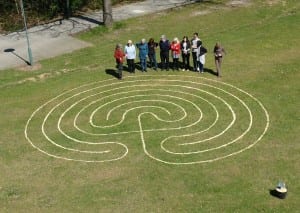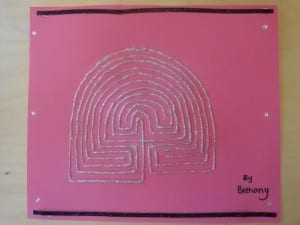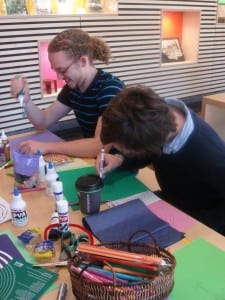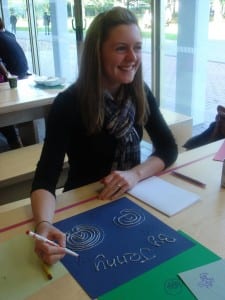Jeff and Kimberly Saward visited the University of Kent earlier this year for a lively seminar and a practical introduction to labyrinth-making –on the cheap! We started with an introduction to the history of labyrinths, followed by an opportunity to draw many different seed patterns. Then it was out to the chosen site, to see what we could do.
We set out to create a seven-circuit classical labyrinth from chopped corn (chickenfeed). The instructions can be found on Jeff and Kimberly’s Labyrinthos website, http://www.labyrinthos.net/layout.html This includes more photos of the process – mostly showing the team doubled up in concentration. Thanks are due to the Grounds Maintenance Team who recommended the site and made sure the grass was newly mown, and to the Biosciences Office who found a room for the photographer, looking down on the event as it proceeded!
The most time-consuming part was choosing the exact starting point, and laying out the seed pattern. For example, we needed to ensure that the completed labyrinth would be well clear of a grassy ditch and a paved footpath. Then the team was divided into runners and walkers. The walkers spaced ourselves out along a rope with ribbons marking our designated places (see the instructions). Each of us had a scoop (plastic bottle, trimmed to shape) full of chickenfeed ready to pour on the ground – it was the job of the runners to keep our scoops topped up. The rope was taut, pegged down at one end – we followed the rope, each of us pouring a narrow line of corn as we went, following the line that our individual ribbon traversed over the ground. Within 20 minutes we had a beautifully constructed labyrinth – ready to walk, run, dance…
This highly enjoyable day was a Creative Campus event at the University of Kent and was funded through my National Teaching Fellowship. It provided training for three different groups: volunteers from a primary school, labyrinth enthusiasts at the University, and staff and students from the University’s School of Arts who planned to use the labyrinth in a subsequent dance event. Photos include the expert clearing-up carried out by a campus resident.
Jan Sellers
[nggallery id=12]






